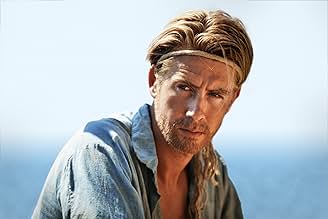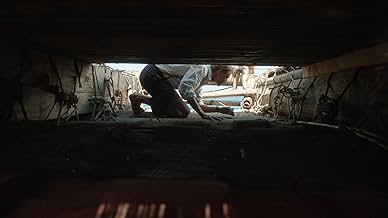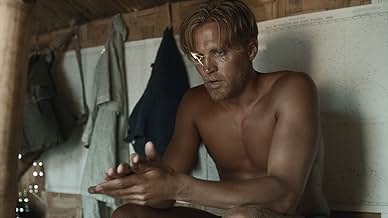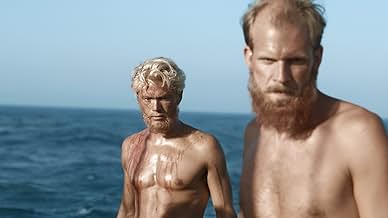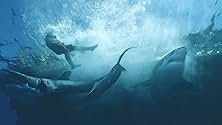Die epische 6.900 Kilometer lange Reise, die der legendäre Entdecker Thor Heyerdal 1947 auf einem Floß aus Balsaholz quer über den Pazifik unternahm, um nachzuweisen, dass es für die südamer... Alles lesenDie epische 6.900 Kilometer lange Reise, die der legendäre Entdecker Thor Heyerdal 1947 auf einem Floß aus Balsaholz quer über den Pazifik unternahm, um nachzuweisen, dass es für die südamerikanischen Ureinwohner in der Zeit vor Kolumbus möglich war, Polynesien zu besiedeln.Die epische 6.900 Kilometer lange Reise, die der legendäre Entdecker Thor Heyerdal 1947 auf einem Floß aus Balsaholz quer über den Pazifik unternahm, um nachzuweisen, dass es für die südamerikanischen Ureinwohner in der Zeit vor Kolumbus möglich war, Polynesien zu besiedeln.
- Regie
- Drehbuch
- Hauptbesetzung
- Für 1 Oscar nominiert
- 12 Gewinne & 14 Nominierungen insgesamt
- Thor Heyerdahl
- (as Pål Hagen)
- Herman Watzinger
- (as Anders Baasmo Christiansen)
- Thor 6 yrs.
- (as Kasper Ameberg Johnsen)
Empfohlene Bewertungen
This is the story about the amazing world famous Kon-Tiki trip crossing the pacific on a balsa-raft just to prove this happened in ancient times, made by the makers of great Max Manus.
The trip, taken on the basis of an idea of the explorer Thor Heyerdahl, was completely ludicrous and no one believed it could be done. and how could a trip like this be told better than by Heyerdahl himself in the documentary made during the trip.
Back in 1947 this was just the story the world wanted to be told after the 2nd world war and the atomic bombings of Hiroshima and Nagasaki. The documentary film from the trip later won Oscar (1951), and the book was translated into 70 languages, and sold more than 50 million copies world wide.
Finally we get to see the trip dramatized as it should be. And the result is really an amazing and epic film which holds two hours of explorer-ism, excitement and awe. I think we really get to imagine how it was to be 6 persons floating on an uncontrollable raft in the middle of nowhere for more than hundred days. The bore, the awe of discoveries, the fear of weather, sharks and whales. The psychological toll, the friendship...
It's a great story and a great film which will make new generations pick up the book with the same name, before they watch the original documentary. Beautifully filmed, well played, even down to Heyerdahl incredibly bad English pronunciation. Not all is accurate. There's been a debate around the premiere about making Herman Watzinger such a wimpy character, when we actually was a Norwegain 100 m record holder and a strong guy with good looks, but the writers found the story needed heart, and not only bald and crazy feeling-less young men. I agree. Over 100 days on a raft is at least 90 days of boredom.
Thor Heyerdahl himself made this trip to prove his idea, which no one would believe, and later got famous. He made the trip though he was not only not able to swim, but actually afraid of water, can you imagine! And it also tells the story of those left behind, wife and kids.
This is the most expensive Norwegian film production ever, and the story is a Norwegian sacred explorers story, as good as they come, changing world history. Thankfully the film floats as good as the raft, and is well wort ha watch. Great manuscript, beautifully filmed, good handcraft.
The film comes in both a Norwegian and an international (English) spoken version, which gives the movie a possibility to be shown all over the world. And it will. Treat yourself to an insane, but epic trip, and get to be an explorer yourself. This is great storytelling! It loses one of 10 stars due to the irritating (though factual) English pronunciation of Heryerdahl. Not necessary to re-experience that to make a good story.
I'm not saying this just because I'm Norwegian and extremely proud that my country managed to produce this amazing adventure. Kon-Tiki is definitely one of the most original, well- written and fun films I've seen this year.
It's the 1940s. Without spoiling the story (which is real by the way), we are invited to follow Thor Heyerdahl as he gathers a crew of overly confident Scandinavians attempting to cross the Pacific on a balsa wood raft. All in the name of science and a boyish thirst for adventure! This attitude is understandable; after enduring the misery of WW2, little seemed more tempting than escaping to faraway exotic lands. Bravery or stupidity? In either case, viewers can look forward to one hell of a boat ride.
What I adore about Kon-Tiki is the presentation of the raft's surroundings. The Pacific Ocean is just as magnificent and beautiful as it is dangerous and merciless, and this dynamic is perfectly balanced. Peaceful waters and clear skies suddenly give way for dangerous sea- creatures and storms mighty enough to tear the old-fashioned raft apart. Kon-Tiki is simply grand. At times my adrenaline rose, my heart started pumping, and I started lusting for adventure myself - just by watching.
Another strong point is the cast. The actors do a brilliant job at depicting the slightly eccentric yet adventurous Scandinavians far away from their Nordic comfort zone. Thor Heyerdahl is particularly well portrayed with his dreamer-like attitude and awkward English skills. Although I would prefer more emphasis on character development, Kon-Tiki make them just interesting enough for viewers to care for them.
Kon-Tiki is such a delight to watch, because it's original, different and not your typical Hollywood adventure flick. No, the plot is not complex. It has no twists or turns, and Kon-Tiki certainly doesn't contain the amount of drama you'd expect. And this is what makes it good - the film is all about the sheer excitement of the adventure. Of course it isn't perfect, but for a Norwegian film, I'd say it holds its ground rather strongly.
I honestly haven't had this much fun with a film for a long while. If you're lucky, Kon-Tiki might show up on a festival or international cinema near you. In that case, do watch it.
Awesome retelling about the dangerous adventure starred by Thor and a valiant group of heroes . Big budget production with gorgeous scenarios , colorful images , thrills , emotion and sense of style . Large parts of the film were filmed in two versions at the same time, one in Norwegian, the other in English, in order to secure international funding. Including wide participation from several nations , as there take part Sweden, Bulgaria , Norway , Malta , Maldives crews . Glamorous and glimmer cinematography by Geir Hartly Andreassen . Special mention to sensitive as well as evocative original Music by Johan Söderqvist . Lavishly produced among several countries such as UK | Norway | Denmark | Germany | Sweden with important financing by great producer Jeremy Thomas . The film's producer, Jeremy Thomas, had wanted to make the film since 1996 and was granted the rights to the story by Thor Heyerdahl before the latter's death in 2002 . The motion picture was compellingly directed by Joachim Rønning (Bandidas , Max Manus) and Espen Sandberg and it was the official submission of Norway to the Best Foreign Language Film of the 85th Academy Awards 2013.
The film was well based on real events , these are the followings : Kon-Tiki was the raft used by Norwegian explorer and writer Thor Heyerdahl in his 1947 expedition across the Pacific Ocean from South America to the Polynesian islands. It was named after the Inca sun god, Viracocha, for whom "Kon-Tiki" was said to be an old name. Kon-Tiki is also the name of Heyerdahl's book; the Academy Award-winning documentary film chronicling his adventures; and the 2012 dramatised feature film nominated for the Academy Award for Best Foreign Language Film.Heyerdahl believed that people from South America could have settled Polynesia in pre-Columbian times. Although most anthropologists as of 2010 had come to the conclusion they did not, in 2011, new genetic evidence was uncovered by Erik Thorsby that Easter Island inhabitants do have some South American DNA, lending credence to at least some of Heyerdahl's theses. His aim in mounting the Kon-Tiki expedition was to show, by using only the materials and technologies available to those people at the time, that there were no technical reasons to prevent them from having done so. Although the expedition carried some modern equipment, such as a radio, watches, charts, sextant, and metal knives, Heyerdahl argued they were incidental to the purpose of proving that the raft itself could make the journey.The Kon-Tiki expedition was funded by private loans, along with donations of equipment from the United States Army. Heyerdahl and a small team went to Peru, where, with the help of dockyard facilities provided by the Peruvian authorities, they constructed the raft out of balsa logs and other native materials in an indigenous style as recorded in illustrations by Spanish conquerers. The trip began on April 28, 1947. Heyerdahl and five companions sailed the raft for 101 days over 6900 km (4,300 miles) across the Pacific Ocean before smashing into a reef at Raroia in the Tuamotu Islands on August 7, 1947. The crew made successful landfall and all returned safely.Thor Heyerdahl's book about his experience became a bestseller. It was published in Norwegian in 1948 as The Kon-Tiki Expedition: By Raft Across the South Seas, later reprinted as Kon-Tiki: Across the Pacific in a Raft. It appeared with great success in English in 1950, also in many other languages. A documentary motion picture about the expedition, also called Kon-Tiki was produced from a write-up and expansion of the crew's filmstrip notes and won an Academy Award in 1951. It was directed by Thor Heyerdahl and edited by Olle Nordemar. The voyage was also chronicled in the documentary TV-series The Kon-Tiki Man: The Life and Adventures of Thor Heyerdahl, directed by Bengt Jonson.The original Kon-Tiki raft is now on display in the Kon-Tiki Museum in Oslo.
Anyway, even though I have not watched nor have any knowledge of the original, I am impressed with the way this film was made. It was pretty well-balanced with no major flaws in my opinion. Well acting performances by the cast were complemented by a high level of cinematography technique that made looked like the entire journey on the raft was really shot wide in the ocean. Like Life of Pi, there were certain marine animals that were infamously being shown from the real life account of Kon-Tiki, and the CGI made on the animals were so real you probably cant tell if those animals were fake.
Probably the major point of improvement that the film can work on is the lack of character development of the other participants in the Kon Tiki, aside from Thor Heyerdahl himself. I am not implying there was none, as we get to see Thor's mates conflicts happening from the start till the end, but I wish I could have known more why they decided to join and their background story. Understandably, with the time given the film had chosen to focus on Thor instead with a lot of plot material explaining why he had to venture into such a journey.
I was also curious if there were more that could be shown about a group of men enduring a raft journey across the ocean in +100 days. But overall, just by solely comparing the similarities, this is much better and believable than Life of Pi as well as a very satisfying movie experience.
*** (out of 4)
Visually stunning telling of explorer Thor Heyerdahl's (Pal Sverre Hagen) epic and now legendary journey traveling nearly 5,000 miles from Peru to Polynesia in a wooden raft. Directors Joachim Ronning and Espen Sandberg certainly do a marvelous job in bringing this story to the screen, although I think the screenplay at times could have given more information than what we're just seeing. I think a little more character development might have helped the film somewhat but there's still no question that this here is mighty impressive and especially considering the budget. I think the best thing in the film is the wonderful visuals and right from the start they just leap right off the screen. Whether it's the snowy landscape of Norway or the beautiful blues of the sea, the look of this movie is something that makes you just want to pause the film and admire its beauty. The cinematography is top-notch and I'd argue some of the best that I've seen in recent years. The cinematography certainly helps grab all of these beautiful images but I also think it's so good that it also takes the viewer and places them directly on the boat to experience everything that happens. As for the real story, seeing it unfold here makes for a thrilling adventure that deals with some bickering between the men but also some breathtaking moments involving a whale and some highly intense scenes with sharks. The acting is another major plus as all the key people do a wonderful job in the film even while none of their characters really jump out at you except for the lead. The film is certainly very uplifting and inspirational and it really makes you respect these explorers for everything they did and of course their bravery. This film is certainly a fitting tribute to the men who went on this mission.
Wusstest du schon
- WissenswertesLarge parts of the film were filmed in two versions at the same time, one in Norwegian, the other in English, in order to secure international funding. See ALTERNATE VERSIONS section for greater detail.
- PatzerThe crew were not worried about whether the ropes would hold the float together, as it is portrayed in the film. As we can see in the Kon-Tiki (1950) documentary, the balsa wood was much softer than the rope, and it was actually the rope that ate through the wood. The result was that the rope eventually was protected by the space that had been created around it.
- Zitate
Epilogue: Bengt fell in love with Polynesia. He settled there and became a Consul General of Sweden. He died in 1997.
Epilogue: Erik built himself a sailboat, that became his home for 11 years. He worked as an artist until his death in 1972.
Epilogue: Torstein kept going on expeditions. He died in 1964 during an attempt to reach the North Pole on skis.
Epilogue: Knut resumed his career in military intelligence. He was also instrumental in the establishment of the Kon-Tiki museum. He died the Christmas of 2009.
Epilogue: Herman became the director of UN's Food and Agriculture organization. He died at Titica lake in 1986.
Epilogue: Thor wrote a book about Kon-Tiki. It was translated to over 70 languages, and sold over 50 million copies. The documentary about the expedition won an Oscar. Liv and Thor divorced after the Kon-Tiki expedition. Their boys lived with Liv, who later moved to the US where she died in 1969. Thor continued his work as an experimental archaeologist, author and explorer. He died in 2002.
- Crazy CreditsBefore the closing credits, short clips are shown in which original footage shot by Heyerdahl was reenacted by the "Kon-Tiki" actors: urinating overboard in the open sea, dancing with natives under palms, portraits, and the like. Along with this, brief notes concerning each crew member's path of life after the trip are given.
- Alternative VersionenIn an unusual technique, the film was shot simultaneously in both Norwegian and English, with each scene being filmed twice, first in Norwegian and then in English, with the same actors. This resulted in two versions of the film to be released, one primarily for the Norwegian domestic market, the other for an international audience. In a few cases, such as action scenes and computer-generated sequences, they used the same shot, later adding English with dubbing.
- VerbindungenFeatured in 70th Golden Globe Awards (2013)
- SoundtracksFlickan i Havanna
("The girl in Havana")
Lyrics by Evert Taube (as Taube) and music by Horatio R. Palmer (as Palmer)
Top-Auswahl
Details
- Erscheinungsdatum
- Herkunftsländer
- Offizielle Standorte
- Sprachen
- Auch bekannt als
- Thor Heyerdahls Kon Tiki
- Drehorte
- Nu Boyana Film Studios, Sofia, Bulgarien(New York exterior scenes)
- Produktionsfirmen
- Weitere beteiligte Unternehmen bei IMDbPro anzeigen
Box Office
- Budget
- 16.600.000 $ (geschätzt)
- Bruttoertrag in den USA und Kanada
- 1.517.410 $
- Eröffnungswochenende in den USA und in Kanada
- 22.168 $
- 28. Apr. 2013
- Weltweiter Bruttoertrag
- 22.842.887 $
- Laufzeit1 Stunde 58 Minuten
- Farbe
- Sound-Mix
- Seitenverhältnis
- 2.35 : 1
Zu dieser Seite beitragen






